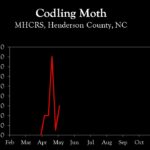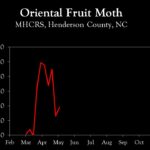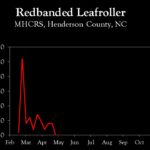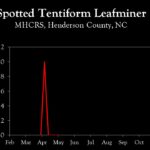WNC Orchard Insect Pest Populations – May 9, 2023
go.ncsu.edu/readext?935042
en Español / em Português
El inglés es el idioma de control de esta página. En la medida en que haya algún conflicto entre la traducción al inglés y la traducción, el inglés prevalece.
Al hacer clic en el enlace de traducción se activa un servicio de traducción gratuito para convertir la página al español. Al igual que con cualquier traducción por Internet, la conversión no es sensible al contexto y puede que no traduzca el texto en su significado original. NC State Extension no garantiza la exactitud del texto traducido. Por favor, tenga en cuenta que algunas aplicaciones y/o servicios pueden no funcionar como se espera cuando se traducen.
Português
Inglês é o idioma de controle desta página. Na medida que haja algum conflito entre o texto original em Inglês e a tradução, o Inglês prevalece.
Ao clicar no link de tradução, um serviço gratuito de tradução será ativado para converter a página para o Português. Como em qualquer tradução pela internet, a conversão não é sensivel ao contexto e pode não ocorrer a tradução para o significado orginal. O serviço de Extensão da Carolina do Norte (NC State Extension) não garante a exatidão do texto traduzido. Por favor, observe que algumas funções ou serviços podem não funcionar como esperado após a tradução.
English
English is the controlling language of this page. To the extent there is any conflict between the English text and the translation, English controls.
Clicking on the translation link activates a free translation service to convert the page to Spanish. As with any Internet translation, the conversion is not context-sensitive and may not translate the text to its original meaning. NC State Extension does not guarantee the accuracy of the translated text. Please note that some applications and/or services may not function as expected when translated.
Collapse ▲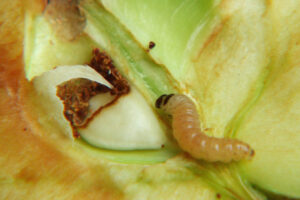 The abrupt increase in temperatures has accelerated emergence of first generation codling moth, which is the key pest of concern at this time. Degree-day (DD) accumulations in lower elevation orchards (e.g., Cleveland County) are about 400 as of today (9 May), which is equivalent to about 60% adult emergence and 7% egg hatch. Now through the next 2 to 3 weeks presents the greatest potential threat by first generation CM in these lower elevation orchards. In Henderson County and similar elevations (2100 ft), DD accumulations are 233 as of today. First generation egg hatch begins at about 250 DD, which will occur over the next couple of days. In recent years codling moth populations have been fairly low in many commercial orchards, and under those conditions an initial insecticide application can be delayed to about 350 DD, which will occur early next week.
The abrupt increase in temperatures has accelerated emergence of first generation codling moth, which is the key pest of concern at this time. Degree-day (DD) accumulations in lower elevation orchards (e.g., Cleveland County) are about 400 as of today (9 May), which is equivalent to about 60% adult emergence and 7% egg hatch. Now through the next 2 to 3 weeks presents the greatest potential threat by first generation CM in these lower elevation orchards. In Henderson County and similar elevations (2100 ft), DD accumulations are 233 as of today. First generation egg hatch begins at about 250 DD, which will occur over the next couple of days. In recent years codling moth populations have been fairly low in many commercial orchards, and under those conditions an initial insecticide application can be delayed to about 350 DD, which will occur early next week.
In orchards using mating disruption, supplemental insecticides are usually not necessary against the first codling moth generation. However, pheromone traps should be deployed to confirm that populations are indeed low (<3 cumulative moths/trap over a two week period). An insecticide is recommended against first generation tufted apple bud moth (TABM), but that timing will not be for at least 3 weeks.
For those who are concerned about San Jose scale, and where early emerging codling moth populations are relatively low, Assail should be considered as a first cover spray. Assail will provide good control of low codling moth populations and is also very effective against San Jose scale crawlers.
Preventive Control of European Red Mite: With increased pyrethroid use against stink bugs in recent years, preventive control of European red mite (ERM) has become a more common practice. Preventive products include Apollo, Savey, Zeal, Envidor and Agri-Mek. Petal fall to second cover is generally the best timing for these applications, because they are most effective when ERM are still low. There have already been reports of ERM appearing in significant numbers in some orchards. Agri-Mek should be applied at petal fall to first cover, with either a horticultural oil or penetrating adjuvant to maximize uptake by leaves – if using oil do not use within 14 days of Captan applications. For resistance management purposes, products with different modes of action should be rotated annually. Apollo and Savey are the same mode of action (MOA group 10A), so do not use either of these in successive years.
Learn more about southeastern apple insect pests at the Apple Insect Management page.
2023 Average Weekly Trap Captures
| HENDERSON COUNTY | |||
| Insects per trap | |||
| Apr 24 | May 1 | May 8 | |
| Codling moth | 8.0 | 0.5 | 3.0 |
| Oriental fruit moth | 89.5 | 26.0 | 38.0 |
| Tufted apple bud moth | 19.0 | 9.0 | 6.0 |
| Redbanded leafroller | 4.0 | 0.0 | 0.0 |
| Obliquebanded leafroller | – | – | – |
| Lesser appleworm | – | – | – |
| Apple maggot (abandoned and research orchards) | – | – | – |
| Brown marmorated stink bug (commercial) | – | – | – |
| Brown marmorated stink bug (unsprayed) | 1.5 | 0.0 | 0.0 |
| Spotted tentiform leafminer | 0.0 | 0.0 | 0.0 |
| Dogwood borer | 0.0 | 1.0 | 4.0 |
| Peachtree borer | 0.0 | 0.0 | 0.0 |
| Lesser peachtree borer | 45.0 | 7.0 | 7.0 |
| San Jose scale | 0.0 | 0.0 | 0.0 |
*Note that these averages illustrate only the timing of insect emergence and fluctuations in populations, and are not representative of population levels in any given orchard. The only way to have an accurate assessment of an individual orchard’s populations is to set up traps in that orchard.
2023 Accumulated Degree Days
| HENDERSON COUNTY | ||||
| Apr 24 | May 1 | May 8 | ||
| Codling moth (Biofix: April 7) | 130 | 170 | 220 | |
| Oriental fruit moth (Biofix: March 24) | 366 | 433 | 508 | |
| Tufted apple bud moth (Biofix: April 21) | – | 80 | 155 | |



